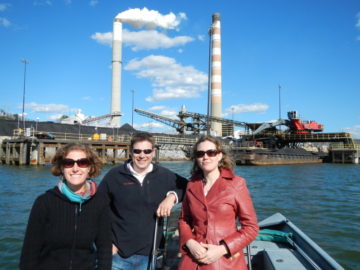This blog was written by Amelia Shenstone, former Regional Advocacy Director with the Southern Alliance for Clean Energy.
Guest Blog | March 26, 2013 | Alabama, Coal, Georgia, Utilities
Last week I had the privilege of accompanying experts from the Union of Concerned Scientists (UCS) on a three-day tour of Georgia and Alabama to highlight coal plants that should be considered for retirement. UCS is a national, science-based non-profit that advocates for policy decisions that are based on credible research.
UCS’s report, Ripe for Retirement: The Case for Closing America’s Costliest Coal Plants, found that Georgia and Alabama top the list of states with coal-fired electric generation capacity that’s economically vulnerable. SACE helped release the report in the Southeast and we were proud to welcome UCS staff Jeff Deyette and Megan Rising to tour these two states and discuss their findings with advocates, media, and decision-makers. Jeff is assistant director of energy policy and a co-author of the report; Megan is UCS’s energy campaign manager.
The report applies an “economic stress test” to coal-fired generators across the country to see whether they could still provide cost-competitive energy after being upgraded with modern pollution controls aimed at protecting public health. It identifies several market stresses, including the low price of natural gas and increasing competition from renewable energy, that contribute to coal-fired units becoming less economical than cleaner alternatives.
In Georgia, ten of the coal-fired generating units UCS identified as “Ripe for Retirement” are now proposed for retirement as part of Georgia Power’s triennial Integrated Resource Plan, due for review by the Public Service Commission this spring. SACE, other advocacy groups, and the public will have an opportunity to weigh in, and we’ll encourage the PSC to approve retirement of the proposed generators at Plants Harllee Branch, Yates, and Kraft. Those units average 54 years old, far beyond the expected 30-year lifespan of a coal plant.
 To provide a national perspective on how those proposed retirements reflect national trends and market pressures, we kicked the tour off with a lunch co-sponsored and hosted by our friends at GreenLaw. About 30 activists, renewable energy business owners, students, and other supporters turned out to hear UCS’s view of Georgia’s oldest coal plants.
To provide a national perspective on how those proposed retirements reflect national trends and market pressures, we kicked the tour off with a lunch co-sponsored and hosted by our friends at GreenLaw. About 30 activists, renewable energy business owners, students, and other supporters turned out to hear UCS’s view of Georgia’s oldest coal plants.
In the evening we headed to Alabama, where the situation is vastly different: Alabama Power has yet to announce any generator closures, and the process for Public Service Commission review of the utility’s plans is much less transparent. The report found that 24 generating units at 7 plants in Alabama were “ripe for retirement,” and all but two of those plants are owned by Southern Company, the parent of Alabama Power. The 42-plus year old Gorgas Steam Plant, pictured at right, is one of those flagged in the report – up to 4 of its 5 generators should be considered for retirement.
During our visit, we met with clean air advocates, Riverkeepers, consumer groups, environmental attorneys, print and TV reporters, and government staff to brief them on the report as a tool for analysis and advocacy around Alabama Power’s future generation plans. Despite our requests, representatives from Alabama Power were unavailable to meet with us during the trip.
In Birmingham, we were treated to a surprise tour of the Gorgas plant via the water, courtesy of Black Warrior Riverkeeper. In addition to the hazy emissions from the stack (see above), which contribute to air pollution, we were discouraged to see coal dust blowing straight into the river as the wind scoured the coal piles waiting to be burned, and as coal was loaded onto a barge for the trip from the end of the rail line to the plant.

Along with these plants being old and uneconomical, coal plants also threaten water. Underscoring the dangers the Gorgas Steam Plant poses to the river and its human users, I snapped this picture of a fisherman, who said he’d been fishing there for 50 years, just below the 70-foot earthen dam containing the plant’s 3.5 billion gallon coal ash impoundment and right in the effluent water from the ash (coming out of the pipe on the left). He seemed concerned about certain aquatic changes he’d noticed but obviously wasn’t aware of the toxic materials that can leach from coal ash (for more, look up Gorgas on SouthEastCoalAsh.org).

I’d like to extend a big THANK YOU to everyone who helped make this tour a success, from hosting events to reaching out to reporters, especially GreenLaw, the Southern Environmental Law Center, and Black Warrior Riverkeeper. We hope that the attention UCS’s visit brought to coal plants – and the financial benefits for ratepayers of replacing these plants with cleaner options – will bolster Georgia regulators to approve generator retirements, and encourage Alabama Power to take concrete steps toward retiring some of its oldest units.